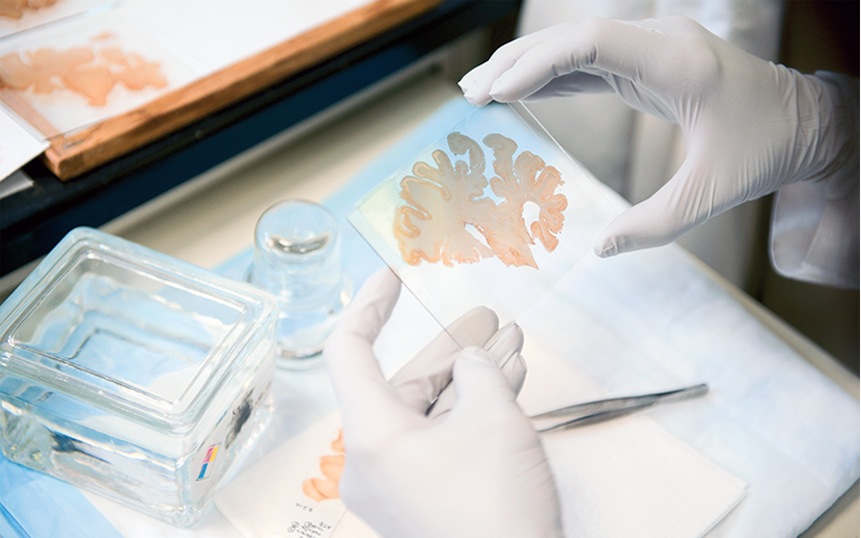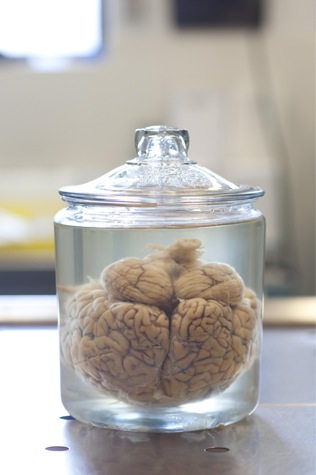Video
In the video above, learn about BU’s research into the links between concussions and a progressive brain disease called chronic traumatic encephalopathy. Video by Devin Hahn
For Ann McKee the scientific inquiry that would change the game of professional football began in February 2008, when NFL linebacker John Grimsley shot himself in the chest while cleaning his gun. To those who knew Grimsley, there were at least two reasons his death looked less like an accident and more like suicide: the former Houston Oiler was an experienced outdoorsman who had grown up with guns, and in the years before his death, he had become forgetful and uncharacteristically quick to anger.
So when McKee, a School of Medicine associate professor of neurology and pathology, dissected the athlete’s brain looking for evidence of neurological impairment, she wasn’t surprised to find it, in the form of brown splotches and dark squiggles that don’t appear in healthy brains. The same abnormalities had been found, McKee knew, in the brains of boxers suffering from dementia pugilistica, or punch-drunk syndrome, as well as in the brains of battered women. Grimsley’s head had also been the object of plenty of battering; he had weathered at least 11 concussions in his years on the playing field. McKee determined that he suffered from a brain disease known as chronic traumatic encephalopathy, or CTE, which in recent years had been found in the brains of four other professional football players. As with Grimsley, the deaths of the others had followed years of strange behavior.
In the four and a half years since that discovery, McKee and Robert Stern, a MED professor of neurology and neurosurgery and cofounder of BU’s Center for the Study of Traumatic Encephalopathy (CSTE), along with CSTE codirectors Robert Cantu, a MED clinical professor of neurosurgery, and former WWE wrestler and Harvard football player Christopher Nowinski, have pushed their exploration of CTE to the forefront of medical knowledge about the brain disorder.
“In 2009, I reviewed every single case of this that I could find,” says McKee. “There were 48 cases in all the world’s literature, plus 3 at Boston University. We are now reporting 68 at BU alone.”
The research conducted at CSTE, a collaborative venture between MED and the nonprofit Sports Legacy Institute, founded by Nowinski and Cantu in 2007, has played a powerful role in persuading an initially reluctant National Football League to make several rule changes designed to reduce the severity and frequency of head trauma to players. Under pressure from politicians and medical researchers, the league also broadcast public service announcements warning youth players of the dangers of concussions and hung posters spelling out the dangers of head trauma in all NFL team locker rooms. And in April 2010, the league surprised CSTE researchers—then among professional football’s most persistent critics—with an unrestricted gift of $1 million. The CSTE has also established a brain bank, a repository for the brains of deceased athletes and others whose hard-knock experiences render them candidates for CTE. The center now holds 85 brains, and close to 500 are promised by living athletes.
Contact Sports and Trauma
“In 2008, we had a handful of cases,” says McKee. “At that point, we knew what the disease looked like, but we weren’t sure if we had just got some bad cases. Now we’ve seen mild disease in high school athletes and college athletes, and we’ve seen profound disease in some elderly retired football players. We have a very clear idea of how the disease progresses through the nervous system, and we realize because of the ease of collecting all these cases that it must be more prevalent than we ever thought.”
The BU researchers have identified CTE in 68 of the 82 brains they’ve examined, including those of professional hockey players, and even in the brain of a high school football player. Now, the same revelations that shook professional football are raising questions about the safety of other contact sports and other levels of play. McKee says that like football, hockey has subconcussive head collisions “built into the game.”
“Soccer has it built in, too,” she says, “especially when it comes to goal kicks, when the ball is traveling at a tremendous velocity.”
The researchers have come to suspect that CTE is caused by prion folding, the mysterious folding of proteins that is believed to be the cause of mad cow disease. McKee speculates that the harmful folding progresses when a normal protein comes in contact with an abnormal protein, turning the normal protein bad.
At this point, says McKee, researchers are convinced that the best way to avoid the disease is to make sure that any person with a concussion gets plenty of rest, both physically and cognitively, until he is free of symptoms. “The best evidence we have suggests that it’s injury on top of unresolved injury that is most likely to trigger this,” she says.
Last year, McKee and Lee Goldstein, a MED associate professor of psychiatry, neurology, ophthalmology, pathology, and laboratory medicine and a College of Engineering associate professor of biomedical engineering, expanded the list of suspect activities when they found CTE in the brains of four military veterans who had been exposed to blasts from improvised explosive devices. Because three of the four vets whose brains were studied had suffered concussions prior to their military service, the researchers tested the apparent relationship of blasts to CTE by exposing anesthetized lab mice to a simulated explosion. As expected, the exposed mice developed brain tau, a harmful protein found in the brains of CTE victims, as well as other signs of CTE. The mice also suffered memory and learning problems—for example, those that had been exposed to the blast found it harder to escape from a maze than did a control set of mice. By contrast, mice exposed to a simulated blast with their heads immobilized did not suffer learning and memory impairments. McKee and her colleagues now wonder where the list of CTE-spawning trauma will end.
“People have written to me about domestic abuse and child abuse,” says McKee. “There are people in prison who have been subject to physical abuse and don’t have normal brain function. And you wonder about things like motor vehicle accidents. Then you have the most common cause for concussions: people falling down.”

Researchers have come to suspect that CTE is caused by prion folding, the mysterious folding of proteins that is believed to be the cause of mad cow disease.
The CTE Defense
One profound implication of the realization that repeated head trauma leads to a brain disorder that can make those injured violent, says McKee, is CTE’s potential as a legal defense for people accused of violent crime. In fact, she says, some CSTE researchers have already been contacted by defense lawyers.
For the time being at least, the CTE defense is kept from the courtroom by the necessity of dissecting a brain in order to identify the disease, but that is likely to change. Stern is working with 100 retired NFL players, all with symptoms consistent with CTE. At this point, he says, it’s too early to say that there are reliable chemical indicators of CTE, but “the findings are interesting.”
Stern has also begun a study that will eventually involve 1,000 athletes—500 are currently enrolled—over the age of 18 representing many different sports. That study, which will follow the athletes throughout their lives, will consist of annual telephone interviews, web-based exams, and DNA analysis.
“This is a first step,” says Stern, “but it’s the most important. In order to move our field forward, we need to know who is likely to have the disease. Then we can do a study of risk factors as well as clinical trials to treat or prevent it.”
As CSTE researchers pry open one Pandora’s box after the other, they remain firmly focused on the upside. Their research has made football a safer sport, and it may well do the same for hockey and other contact sports. If efforts to expand the brain bank internationally succeed, CSTE scientists will someday be studying the brains of rugby players and soccer players.
And then, Stern notes, there are the unintended contributions to the entertainment industry: in the past year, TV shows that have aired episodes about CTE include Harry’s Law (with a researcher who looked a lot like Stern), Law & Order (with a researcher who looked a lot like McKee), The Good Wife, and House. ■

Comments
On 1 November 2012 at 3:11 AM, Rosemary Watts-Dreyer wrote:
I had mild traumatic brain injury in 2006 from a fall and hit my face on the corner of a wall. This was my third concussion. Fascinating article. I'd love to learn more.
On 25 October 2012 at 11:24 AM, George C.Mitchell, MD (MED/BUSM’74) wrote:
I think Dr. Robert Stern and all the staff associated with the CSTE have done a wonderful job in bringing CTE to everyone's attention, including the NFL. Their research is ongoing, and hopefully will bring the day CTE can be diagnosed before death, and hopefully treated. They all deserve all our support.
Post Your Comment